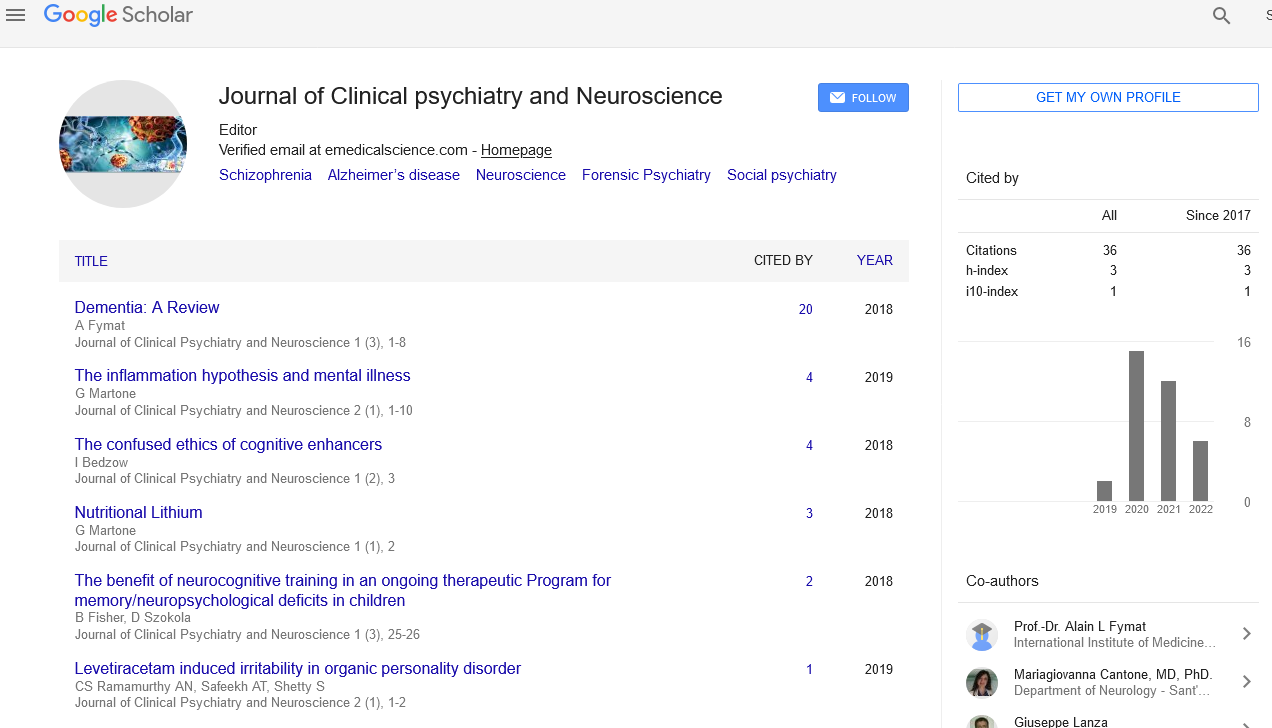Global burden of disease research findings show changes in the prevalence of depression between 1990 and 2017
Received: 07-Mar-2023, Manuscript No. puljcpn-23-6394; Editor assigned: 09-Mar-2023, Pre QC No. puljcpn-23-6394 (PQ); Accepted Date: Mar 26, 2023; Reviewed: 12-Mar-2023 QC No. puljcpn-23-6394 (Q); Revised: 14-Mar-2023, Manuscript No. puljcpn-23-6394 (R); Published: 27-Apr-2023, DOI: 10.37532/ puljcpn.2023.6(2).97-8
Citation: Winston P. Global burden of disease research findings show changes in the prevalence of depression between 1990 and 2017. J Clin Psychiatry Neurosci. 2023; 6(2):97-8.
This open-access article is distributed under the terms of the Creative Commons Attribution Non-Commercial License (CC BY-NC) (http://creativecommons.org/licenses/by-nc/4.0/), which permits reuse, distribution and reproduction of the article, provided that the original work is properly cited and the reuse is restricted to noncommercial purposes. For commercial reuse, contact reprints@pulsus.com
Abstract
Depression is a prevalent mental health condition that can harm both the mind and body. A loss of interest in routine tasks, sleeplessness, an inability to appreciate life, and even suicidal thoughts are the key signs of depression. In most nations today, depression is a prevalent chronic illness that can negatively impact quality of life, interfere with daily activities, and induce depressed thoughts. Patients with major depressive illness also have higher risks of cardiovascular disease, obtaining subpar care, and having higher morbidity and death rates.
Key Words
Routine Tasks; Sleeplessness
Introduction
Depression, which the World Health Organization (WHO) lists as the leading cause of disability worldwide, is thought to affect more than 300 million people worldwide. The fact that teenagers with severe depression are 30 times more likely to commit suicide is one of the most concerning factors. Depression is currently one of the most significant worldwide health issues, however despite the fact that it is recognized that cultural, psychological, and biological variables contributed to depression, its complicated aetiology is still poorly understood.
The Global Burden of Disease (GBD) research offers detailed statistics on various diseases in 195 nations and areas of the world, including details on depression. The GBD database, which separates depression into two main categories—major depressive disorder and dysthymia—provides a plethora of data for studying the prevalence of depression throughout the world. In this study, we examined the temporal patterns in the incidence of depression using data on depression from the GBD database from 1990 to 2017. Our results will contribute to a better understanding of the global impact of depression and the creation of potent preventive measures.
A significant contributor to disability and a serious public health issue is depression. In order to examine depression trends from 1990 to 2017 and the worldwide burden of depression, this study examined data that had been published in the GBD database. Governments in all regions can use the findings of this study to create suitable depression prevention strategies.
According to this report, there were 49.86% more incident instances of depression globally between 1990 and 2017. Lesotho, a poor landlocked nation surrounded by South Africa and with the thirdhighest rate of HIV infection globally, the highest rate of HIV transmission among southern African nations with high prevalence rates, and the lowest coverage of antiretroviral therapy, had the highest ASR. People with HIV/AIDS frequently experience societal stigma and limitations in their ability to get married and work, which can sometimes result in divorce and family estrangement. For a variety of causes, including excessive worry about the disease's development, discomfort, and mortality, people with HIV may feel depression. Due to these aspects of the situation in Lesotho, avoiding AIDS may be essential.
According to our findings, both global and regional proportions of both forms of depression were largely unchanged, with a significant share of patients suffering from severe depressive illness. Major depressive illness, which affects around 16% of the world's population, is receiving more and more attention as the most prevalent cause of disability. According to a WHO research, managing major depressive disorder is the best strategy to treat depression because it is expected to overtake cardiovascular disease as the top cause of disability globally by 2030. Even though it has fallen the greatest there, the United States still had the highest ASR for dysthymia in 2017.
The governments of nations with high rates of depression should concentrate on funding pertinent studies to figure out the underlying reasons and implement policies to actively reduce the incidence of depression. It is important to promote healthy behaviors, such as increasing physical activity and quitting smoking and drinking. Patients who have cancer, AIDS, strokes, and other illnesses should be monitored and given the proper drugs to avoid developing depression. People who are already depressed should receive medical treatment and psychological counselling in order to stop suicidal behavior.
The burden of depression has undergone the most thorough examination to date in this study. It did, however, have certain restrictions. We were only able to analyze the worldwide burden of depression according to this classification approach without further subdivision since the analyzed data were first received from the GBD database, in which depressive disorder is divided into major depressive disorder and dysthymia. Second, the risk factors for depression in various nations and regions were not discussed; only the worldwide illness burden of depression was examined. Future research on this topic is required to inform the creation and application of tailored regulations for the management of depression in various nations and regions.





